This review is something of an outlier.
Tested Technology takes a catholic view of its remit to present products to its readers: we’ve covered everything from a single USB cable, to fidget spinners, to complexly capable computing equipment. All, it is to be hoped, at arm’s length from the manufacturer and with the interest of the reader solely in mind.
Products arrive from manufacturers, queuing up to be reviewed, some on loan, many are donations. We don’t rush to be first with the news: we tend to live with these products long enough to get to know them well before daring to pronounce on them.
But one thing we’ve never done is expose readers to items of regular daily use here at Tested Technology Towers. It would be like telling tales on a friend of the family. Too much information about an intimate relationship. And, besides, you don’t want to hear about the electric oven that’s served us well over the past decade. Or our much-loved water distiller. (Well, maybe you do… Perhaps you will…)
But we’re living in curious times. In our new, closed-down world, I’ve become aware that domestic life here is revolving around a piece of equipment that gets us up in the morning, and tirelessly sustains us through the day. It’s a coffee machine. But no ordinary coffee machine. And I do want to tell you about it.
So here I am paying homage to that machine. And to espresso in general…
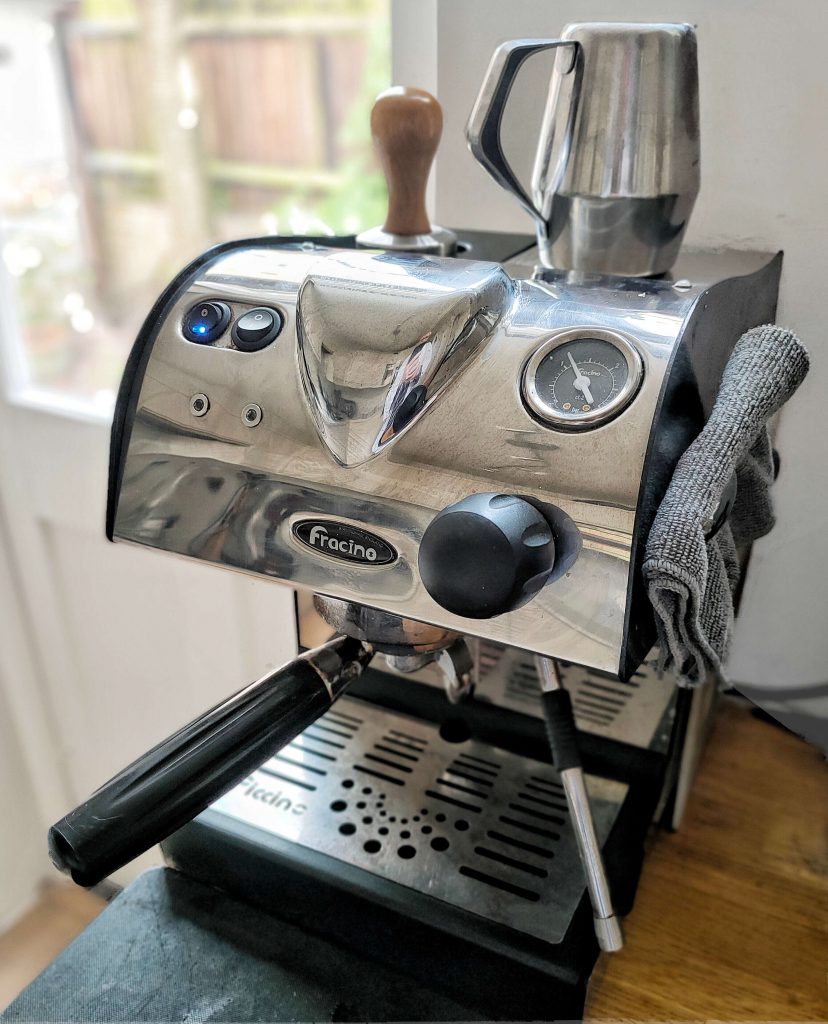 AT THE TIME OF OUR ORIGINAL writing, the Bluestar Coffee site was describing the Fracino Piccino as a “duel boiler” machine. Well, no, the two separate 300ml boilers haven’t challenged one another to a fight. The machine simply uses—unlike most other domestic coffee machines—a pair of boilers, each with its own purpose in life. “Dual boilers” would be the more conventional description.
AT THE TIME OF OUR ORIGINAL writing, the Bluestar Coffee site was describing the Fracino Piccino as a “duel boiler” machine. Well, no, the two separate 300ml boilers haven’t challenged one another to a fight. The machine simply uses—unlike most other domestic coffee machines—a pair of boilers, each with its own purpose in life. “Dual boilers” would be the more conventional description.
Why two boilers, then?
Let’s start at the beginning. My beginning with espresso was with a coffee maker from Woolworths. Remember Woolworths? They shut up shop here in the UK back in 2009, so we’re probably talking fifteen years ago. It caught my eye because it claimed to be able to create full, authentic water pressure of 9 bars (9 times the atmospheric pressure at sea level). I knew nothing about espresso at this point, but 9 bars sounded impressive. I bought it. I think it was about £39.
It was solidly made. I was so impressed with it, in fact, that I went back the next day a bought three more, two for friends and one as a spare. It was a reasonable start to what became my useful career as the family’s domestic barista.
Today I wouldn’t say that first device was a “coffee machine”. The espresso aficionados would describe it as a “coffee appliance”. Small, cheap, corner-cutting, it was able to produce what you could get away with calling espresso. And as it had a steam wand, could also create what you might be able to pass off in some circles as “cappuccino”.
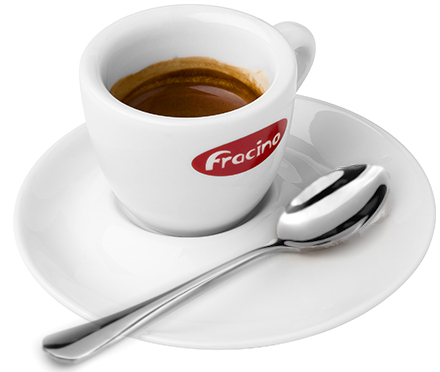
Yes, this sounds snobbish. I’m half-way to becoming a coffee snob. But from this half-way position I can look in both directions, affectionately back to that Woolworth’s coffee maker and forward, somewhat, beyond where I am now with the Fracino Piccino. So that might be useful to you if you find coffee interesting. As I assume you do, if you’ve read this far.
During my Doctor Who days at the BBC (we’re talking nearly 40 years ago now) I equipped my script editor’s office with one of those drip machines. Hot water goes over the grounds, through the filter and into the glass jug, with the hotplate keeping it nice and warm for as long as you like.
I was proud of the machine and the coffee it made kept me going all day. And, on many occasions, far into the night.
But it was disgusting. Drip coffee can be perfectly fine for the first cup. But in a machine that obligingly keeps it warm as the hours wear on, it becomes progressively more revolting. Owning a drip machine with a hotplate should be a criminal offence.
I realise now that the experience of that daily Doctor Who coffee was probably the principle reason I was so ready to embrace the Woolworths device. It made drinkable coffee. Cup by cup. Each cup fresh.
Well, fresh?
I’ll come back to that later when we discuss pressure filters.
Espresso? How so?
But let’s talk about the key difference between my Doctor Who coffee era and my Woolworth’s coffee era.
When you pour hot water slowly over relatively coarsely ground coffee, you’ll be only partially extracting the potentially good stuff in terms of oils, flavours and anti-oxidants. Drink it immediately and it can be an enjoyable beverage. But whatever you do, do not leave it to stew.
In the late nineteenth century the Italians began a journey of discovery towards (what I believe to be) the very best way of making the most of what coffee has to offer. Hot water (but not too hot) quickly forced under pressure through a resistant wad of fine coffee grounds. We now call that wad a “cake” or a “puck”.
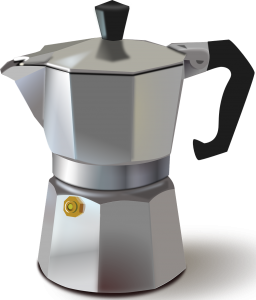
Invented by Alfonso Bialetti in 1933 and named after the Yemeni city of Mocha (confusingly, “Mocha” rather than “Moka” describes a different style of coffee)
The Italians went to great lengths to create that pressure. The simple way was to boil the water in a sealed container and use the steam to force the flow through the coffee puck. This is how the Moka espresso makers work.
It’s an elegant solution with a couple of problems: steam pressure never gets high enough to carry out a proper extraction and boiling water is too hot for the best result, leaching out too much of coffee’s bitter ingredients.
Moka-made coffee is a fine way into espresso but ideally you need more pressure and the water should be cooler, around 85-90°C. So, many other methods of creating the pressure were tried. In the cafe-centric Europe of the 20s and 30s, espresso (it means “made for the moment”—an early example of just-in-time manufacture) was all the rage. But we were still in the age of steam, looking for something better.
World War II put stop to the flurry of espresso machine patents. But in 1945 when things started up again, Achille Gaggia, owner of a cafe in Milan, devised the breakthrough: a hand lever able to bring up the pressure to over 8 bars while allowing the water temperature to stay down around 90°C.
From now on, because of the lever, an espresso shot would be known as “a pull”.
Eight to nine bars and water temperature significantly below boiling point is sacred espresso territory. Snr Gaggia’s coffees tasted magnificent—but there was a catch. His new method produced a suspicious-looking yellowish scum on the surface of the beverage. It alarmed his clientele.
An engineer might have gone back to the drawing board to fix the problem with some added filtration. Snr Gaggia certainly had many of the qualities of Steve Wozniak. But there was a strong element of Steve Jobs about him too. And he knew that this “scum”, while perhaps not itself contributing to the superb taste he was achieving, was certainly a sound indicator of a fully rounded espresso pull.
This new golden surface appearing on the espresso, Snr Gaggia told his customers, is the coffee producing its own cream. “Caffe creme” or “Crema” became the hallmark of a well-pulled espresso.
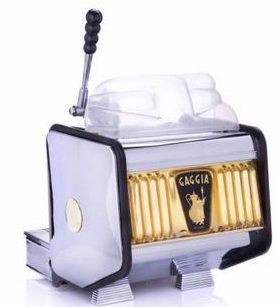
From the The Daniel Di Paolo Collection
With Gaggia’s lever, espresso was almost ready to capture the world. Machines were still complex and expensive, and manual manipulation of the lever also required the skill of a trained barista. So it was through cafes that the fashion spread, powering the “froffy coffee” revolution that as a teenager frequenting London’s Soho I grew up with in the mid-1950s.
And things speeded up in the early ’60s when Ernesto Valente stepped into the picture.
While World War II had completely halted the production of espresso machines, that global disaster had hugely stimulated the production of small, electrically-driven hydraulic pumps. Tanks, submarines and aircraft all relied on them, and by the war’s end in 1945 they had become efficient, reliable, ubiquitous and cheap. Snr Valente thought they would do well in espresso machines.
The Piccino’s Pump
That electric pump of Snr Valente’s is probably the single factor most responsible for unleashing the espresso machine from its (up to that point) mandatory cafe setting and proliferating it into our homes. It makes the Piccino possible and many other styles of domestic machines besides.
The components typically used in the home market will be vibratory pumps. These are especially cheap but only designed for short bursts. As their name implies, they work by feeding an alternating electric current through a coil, using electromagnetism to cause a spring-loaded piston to oscillate rapidly within a wet chamber with a one-way valve. They’re responsible for the uncomfortable noise that domestic espresso machine owners learn to get used to.
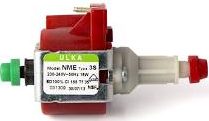
Vibratory pump, costing about £10.
Commercial espresso machines are more likely to be built with expensive rotary pumps. These use a fast spinning paddle wheel with its axle eccentrically located inside a circular chamber. The four chambers created by the paddles are therefore expanding and contracting as the wheel rotates, sucking in water at one side and pushing it out at the other.
Rotary pumps are very much larger and quieter than vibratory pumps, which is why what you mostly hear from a cafe espresso machine is the sound of steam. You can find a useful demonstration of the two types of pump here.
The Piccino’s Dual Boilers
So, at last, we come to the Piccino’s pair of duelling boilers. Mad with jealousy, they face each other at dawn each morning…
The other key ingredient of coffee. The Piccino is fed from a 2L reservoir which needs to be filled manually. There’s no way of determining the water level, other than lifting the lid to peek. But if the level falls too low to fill the boilers they’ll stop heating and you’ll hear a warning beep. (At least, you will if you have good hearing—it’s high pitched and rather quiet.)
Ordinary tap water, particular hard tap water in places like London, presents a problem to machines like the Piccino. The boilers can very easily choke with limescale build-up. For this reason, the Piccino reservoir is fitted with a replaceable filter, which Francino recommends you change every two or three months, depending on the hardness of your water.
The reservoir filter connector is designed for the Brita AquaAroma Crema filter, which it’s worth shopping around for as prices can vary from £10 each to nearly three times that. With a small adaptor, you can also fit the more easily obtainable and slightly cheaper Brita Classic filter. Cheaper still are third party Brita Classic clones.
There are two boilers because any coffee device that claims to be able to produce cappuccino is in the business of heating water to two different temperatures: one for the coffee, another to texture the milk.
There are three different ways of doing this:
- A single water heating system that relies on a time interval to cool or heat the water between these two different uses.
- A single boiler that maintains the higher, steam temperature but has a hollow metal coil running through it to produce the lower temperature water for the coffee.
- A pair of boilers, one for each purpose.
In all three cases the water will be fed in to the heating arrangement from a reservoir or—in the case of commercial machines—through a pump plumbed directly into the water mains supply.
The first instance, you’ll have noticed, doesn’t use the word “boiler”. This is because there two types in this category, only one of which uses a conventional boiler.
An SBDU (single boiler dual use) machine uses a boiler that can operate at two different temperatures, one for brewing and one for texturing milk.
A thermoblock is technically a boiler, in that it can produce boiling water. But it heats a very small amount of water at a time, on the fly, as it flows through the device.
You’ll have guessed from the name that this is a block, often of aluminium, with cooling fins on its outer edges and a labyrinthine narrow water channel coiling through it. The block is electrically heated to either of the two required temperatures under the control of a thermostat.
In the case of both the SBDU and the thermoblock, a switch on the machine allows the user to select between the two temperatures, typically with an indicator to show when that temperature has been reached. The same switch will divert the water output either to the group head or to the steam wand appropriately.
Depending its capacity, the SBDU will typically need significant time to cool off or warm up between roles. The early Gaggia Classic’s solution was to use a small, 30ml boiler made of aluminium.
The thermoblock is (in the spirit of espresso) delivering its output “just-in-time”, heating the water as it flows through the labyrinth. The block is physically small, with low thermal inertia.
Because of their low cost and small size, thermoblocks are used extensively in what we’re calling “coffee appliances”. SBDUs are found largely in entry-level espresso machines like the Gaggia Classic.
The second approach in the above list is called a heat exchanger, or HX. From the point of view of the inner, cooler coil, it’s a thermoblock, but running through steam water rather than aluminium. The advantage over the thermoblock and the SBDU is that both the steam water and the coffee water can be drawn off at the same time.
Like the HX, the dual boiler design also allows steam and espresso-hot water to be delivered simultaneously. Each, of course, will need its own electrical heater and thermostat. From an engineering point of view it’s a straightforward solution but may have a higher production cost than an HX implementation and will certainly be more expensive than a thermoblock.
The dual boiler design is never used in coffee appliances, where the thermoblock is ubiquitous. And the Francino Piccino is a rare exception of the two boiler approach in domestic class espresso machines, where the dominate designs are SBDU or HX.
The Piccino’s Group Head
- Macchina, the espresso machine;
- Macinazione, the proper grinding of a beans—a uniform grind between fine and powdery—which is ideally done moments brewing the drink;
- Miscela, the coffee blend and the roast, and
- Mano is the skilled hand of the barista, because even with the finest beans and the most advanced equipment, the shot depends on the touch and style of the barista.
The Piccino’s brew boiler sits directly on top of and close to the group head, the chrome-plated brass round connection that the portafilter locks into. This proximity helps greatly with an important factor in espresso-making: the thermal stability of the group head. The ideal is that water coming out of the group head onto the puck should maintain a steady temperature during the shot and between shots.
Fracino recommends that you allow a 15 minute interval between switching on the machine and pulling your first shot. A blue LED indicator lights up when the machine starts running and goes out when the brew system is up to temperature. When that happens I briefly flush hot water through the portafilter with an empty basket and once I’ve dried the basket and filled it with ground coffee I go straight ahead with the pull. That way I get an espresso within a few minutes of powering up. See, I’m not yet a full-blown coffee snob.
What the Piccino lacks is the ability to control that temperature manually. A fixed thermostat buried in the entrails determines the boiler temperature and consequently the group head temperature. Unless the machine is modified, the user has no control over this temperature.
The best type of professional barista would probably have no truck with this arrangement, and the average amateur espresso aficionado might be inclined to sneer. The temperature of the water hitting the puck is a key factor in obtaining the perfect shot, and this ideal will vary (somewhere between 80°C to around 95°C) depending on the nature of the bean, the roast, the grind, the tamp, the length of the shot and the mood of the barista.
That’s a lot of variables. The designers of the Piccino were (in my own opinion) quite right to simplify these choices in a machine aimed at the domestic market. If you’re fussy about getting the best out of your beans (and you should be) you simply work the rest of the variables around that constant.
The Portafilter and Baskets
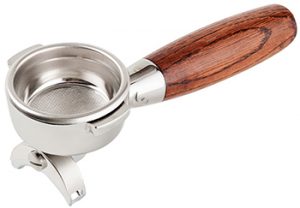 The portafilter is the long-handled lever-like device. The name translates as “carrying the filter” and it does just that. Typically, a machine will be supplied with at least two filter baskets. The portafilter locks with a short twist into the group head forming a tight seal so that pressure can build up in the puck of coffee grounds held in the filter basket.
The portafilter is the long-handled lever-like device. The name translates as “carrying the filter” and it does just that. Typically, a machine will be supplied with at least two filter baskets. The portafilter locks with a short twist into the group head forming a tight seal so that pressure can build up in the puck of coffee grounds held in the filter basket.
A typical portafilter will squeeze espresso out through a pair of spouts in the bottom, spaced so that the output can flow into a single cup or a pair of cups placed side by side. But some portafilters come with a single spout or even with no spout at all, leaving the bottom of the filter basket exposed.
The portafilter supplied by default with the Piccino is the two-spout type. There is much to be said about portafilters and even more to be said about these filter baskets. I pitch in with my own opinions below.
The fact that the Piccino is built in Birmingham, UK was what drew me to it originally. The design is British and has a solid, pre-war British pragmatism about it. Unlike many fancy brand domestic coffee machines, this one is built to be maintainable. Fracino’s main business is selling multi-group, professional espresso machines to the world—including Italy—and the Piccino is the only machine in its catalogue classified as Domestic. The Italian name might be interpreted as “runt of the litter”.
 Frank Maxwell started the business in his garden shed in 1964. The Italian-sounding name, which seems to seduce even the natives of Italy, where the company does brisk business, is a portmanteau word derived from “Frank” and “Cappuccino”.
Frank Maxwell started the business in his garden shed in 1964. The Italian-sounding name, which seems to seduce even the natives of Italy, where the company does brisk business, is a portmanteau word derived from “Frank” and “Cappuccino”.
Professional espresso portafilters are heavy, chrome-plated brass, not just to stand up to constant use but because weight gives thermal stability. Professional espresso portafilters are also designed to take baskets that are 58mm in diameter.
So you might expect the “Domestic” class Piccino to depart from these standards. Most domestic espresso appliances do. A domestic portafilter may be aluminium, as it was on my Woolworth’s coffee maker. And the diameter of those Woolworths filter baskets was around 52mm. That smaller diameter is typical of this class of machine.
The good news is that the Piccino uses professional standard parts. Not just the portafilter and the baskets, but the internals as well. The Maxwell family who set up (and still run) the company in the early ’60s, devised an appropriately Italian name for it, “House of Maxwell” (although no relative) being already associated with a very different kind of coffee.
 Back then the Italians had had a good fifteen years to master the art of modern espresso machine building and their components were the best in the world. Fracino used them in its own machine designs. And still does. (You can find a full schematic of the Piccino here.)
Back then the Italians had had a good fifteen years to master the art of modern espresso machine building and their components were the best in the world. Fracino used them in its own machine designs. And still does. (You can find a full schematic of the Piccino here.)
So the portafilter you get with the Piccino is the heavy-duty, industry standard size, taking industry standard baskets. I think this is important.
Industry standard baskets are stainless steel pressings with a flat bottom perforated with—in the case of the double basket—around 700 small holes. Single baskets, designed to fit the same portafilter, have sides that slope inwards towards a smaller circular base, which will have fewer holes.
But Watch Out for those Pressure Filter Baskets
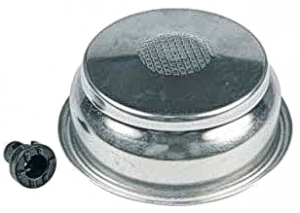
The Gaggia pressure filter with required “pin”. The bottom is dimpled with multiple cosmetic “holes” but there’s only one physical hole in the centre.
If you inspect a typical home espresso appliance filter basket you’ll see that its base appears to be perforated with small holes, very like a regular commercial espresso filter. On closer examination you’ll discover that its base is false-bottomed. There are two layers of metal, with a gap between them. Turn the filter basket upside down and you’ll see that the bottom layer has only a single exit hole.
This is what the industry calls a “pressure filter”. History doesn’t reveal who invented this device and if it had been me I’d’ve kept quiet about it too. The thing is ingenious—and a complete cheat.*
I’ve mentioned that crema may not necessarily play much part in the ultimate taste of the coffee, but is often regarded as a visual indicator of the excellence of the pull. In the ’70s and ’80s the middle classes began buying early, low cost, domestic espresso appliances, hoping to emulate at home the quality of beverage they’d been getting in the dedicated coffee bars.
The small kitchen appliances delivered espresso, of a kind. But nothing you could seriously call crema.
It wasn’t entirely the fault of the machines. They were probably underpowered as far as pressure is concerned and the water may not have been at the ideal temperature. But the chief culprit would have been the coffee itself. Instead of being freshly roasted and then ground on the spot seconds before the pull, typical fodder for those espresso appliances would have been packaged, ready-ground coffee from the supermarket or grocery store.
The most striking feature of the Vertuo (the name was slimmed down when it arrived in Europe two years later) is the “crema” it produces by rapidly spinning the capsule as the extraction takes place.
If the first ever appearance of crema worried Snr Gaggia’s customers in early post-war Europe, Nespresso’s Vertuo crema would have sent them running for the door. The Vertuo system produces a head of yellowish spume that would put a pint of Guiness to shame.
On the one occasion I sampled a Vertuo I was inclined to ask for a straw to get to the coffee. It was a not uninteresting experience, but had little to do with the coffee we’re discussing here.
Once roasted, coffee beans begin to give out carbon dioxide into the air. Sealed in a vacuum container the carbon dioxide helps preserve the beans and typically they remain respectably useable for months after roasting.
But grinding changes the game completely. Carbon dioxide is released in quantity and the small granules of the grind give the coffee acres more exposure to the air. Even in a vacuum container, ground coffee starts to lose its delicate aromatic oils quickly.
And it’s the combination of oils and carbon dioxide that is key to the creation of crema.
The pressure basket can generate the appearance of crema from even the stalest coffee. The single exit hole ensures that pressure builds up irrespective of the looseness of the grind or whether the puck has been properly tamped down, or tamped down at all.
The brewed coffee squirts from the hole in a fast, thin stream, typically directed at a stump (Gaggia calls it a “pin”) in the centre of the portafilter, designed to turn part of the stream into a light spray. It’s this spray that sits on top of the pull in the cup, posing as crema.
It’s true that the experience of drinking coffee involves more than just taste. Aroma, certainly, but there’s little doubt that pleasing the eye is all part of the enjoyment.
However, a pressure filter means that crema can no longer be a factor in assessing the quality of a pull. So pulls from a pressure filter are not likely to improve, even if they could be improved.
So far Tested Technology hasn’t been able to find this particular patent. However, we have come across US Patent 4,882,982 for “A percolator holding pan for ‘espresso’ coffee making machines enabling delivery of rich ‘espresso’ coffee with a good flavor irrespective of the coffee powder conditions”.
Thanks to our technical contributor and patent attorney-trained, Barry Fox, for tracking that down.
The Piccino and its Baskets
Three kinds of industry standard baskets are provided with the Piccino, and you can expect to find at least two of these bundled with any equivalent espresso machine.
 The Single Basket
The Single Basket The Double Basket
The Double Basket The Blind Basket
The Blind BasketNotes: The espresso aficionado deprecates the single basket. True, its sloping sides prevent the pressure from building up correctly. But if a single shot is what you’re after it’s really the only game in town.
Even deeper than the double basket is the triple basket. This may well be too deep to fit a standard portafilter.
The blind basket can be used with or without a dose of special coffee machine detergent.
Speak Not of Froth
 Yes, we always called it “froffy coffee” back in the ’60s—mostly, I seem to remember, because we were too young to feel confident about pronouncing “cappuccino”. And you’ll see countless YouTube experts teaching you the various ways to “froth milk” for your daily cup of Java.
Yes, we always called it “froffy coffee” back in the ’60s—mostly, I seem to remember, because we were too young to feel confident about pronouncing “cappuccino”. And you’ll see countless YouTube experts teaching you the various ways to “froth milk” for your daily cup of Java.
But those experts are condescending to you. A good barista knows that the magic of the steam wand has nothing to do with “frothing milk”. It is creating the miracle of “microfoam”, turning the milk into a velvety texture of invisibly small bubbles that pours from the jug like cream. Microfoam is not “froth”.
You are texturing the milk. Simply by using that vocabulary you will be elevating yourself among your peers. That’s the easy bit. Actually learning to create microfoam is a different matter altogether. It’s a real skill that takes time to master.
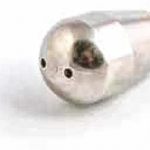 The Piccino’s steam wand is—like so much else of the machine—an industry standard part. It is not one of the many different patented “Auto Frothers” guaranteed to bubble up any jug of milk you care to stick them into. It’s an articulated stainless steel tube on a ball joint that you can move into the best position and angle for your jug. The steam wand ends in a screw fitting designed to hold (in Fracino’s default case) a steam tip with two holes in it. Single hole, triple hole or quadruple hole tips are optional accessories.
The Piccino’s steam wand is—like so much else of the machine—an industry standard part. It is not one of the many different patented “Auto Frothers” guaranteed to bubble up any jug of milk you care to stick them into. It’s an articulated stainless steel tube on a ball joint that you can move into the best position and angle for your jug. The steam wand ends in a screw fitting designed to hold (in Fracino’s default case) a steam tip with two holes in it. Single hole, triple hole or quadruple hole tips are optional accessories.
The single hole tip might be easier for beginners, but the standard double hole tip is very efficient once you learn how to use it. I won’t give lessons here (there are plenty on YouTube) but the basics are:
- Make sure the steam is up to par before putting the steam wand into the milk. Opening up the steam valve and purging the wand into the waste tray is the easiest way to do this. (As a bonus, this action will also tell you whether your waste tray needs emptying—if it does, you’ll hear the waste water bubbling as the steam/hot water hits it below the stainless steel grid).
- Put the steam tip well below the surface of the milk in the best place to create a whirlpool. The idea is to bring the whole liquid up above fridge temperature before you start using the steam to wrap air into the milk. (So the experts tell us. It’s true that the fats in the milk need to be warmed before they’re ready to envelop air, but the local raised temperature at the steam tip may be enough to do this even with fridge-cold milk.)
- Still maintaining the whirlpool, bring the steam tip gradually to just below the surface until the steam starts sniffling air into the milk. You don’t want sneezes, which will create large bubbles, just a nice, steady quiet hiss. During this process, the milk volume should double.
- Once you’ve reached this stage, submerge the steam wand for a final spin of the whirlpool and shut off the steam.
Developing the whirlpool is the tricky part. You can get through a lot of milk before you master this. A perfectly satisfactory substitute for milk while you’re practising is a jug half-filled with water to which you’ve added a drop or two (literally, you need very little) of washing up liquid.

The Daily Grind
If you’ve followed this so far, you may be asking yourself, If I’ve got to grind my own coffee, isn’t there a big piece missing from Tested Technology’s review?
You’d be right.
I haven’t mentioned the grinder.
Espresso coffee making is a bit like hi-fi—and not just because it encourages similar myths, mysteries and snobberies. If you equate the roasted beans to the source of the music, the espresso machine is the loudspeaker system. The grinder, in the middle, is the amplifier.
It’s an important part of the chain. So don’t you really need one of those bean-to-cup machines?
Well, if you like. The market is full of them, some cheaper than the Fracino Piccino. Typically, even the expensive ones won’t have the best kind of grinder. And—as any hi-fi aficionado will tell you—it’s always better to buy separates.
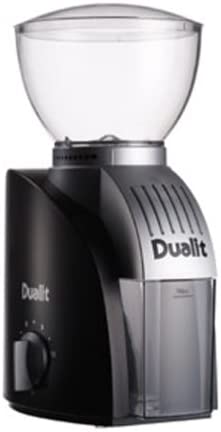 The grinder I first used with the Piccino was the Dualit 75002, an oldie but goodie model that cost me around £100, now apparently superseded by the cheaper 75015.
The grinder I first used with the Piccino was the Dualit 75002, an oldie but goodie model that cost me around £100, now apparently superseded by the cheaper 75015.
My Dualit was a conical burr grinder, which means it ground the beans between a pair of small cone-shaped plates armed with teeth. This gave me a consistent grind, but getting the grind fine enough for espresso could be tricky.
Cheaper grinders don’t actually grind, they use spinning blades to cut the beans to pieces. They cost a lot less to manufacture and you can pick them up for a faction of the price of any burr grinder.
Burr grinders are preferred—some would say mandatory—for espresso, which requires a fine, even grind. Fine, because the hot water is passing quickly through the coffee, so for a proper extraction you need more coffee surface exposure than, say, French Press, where the grounds have much longer contact with the water. And even, because you want the same degree of extraction from every part of the grounds.
A step up from the conical burr grinder is the flat burr grinder. As the name implies, these grind the beans the way a windmill grinds corn. The grind area of a flat burr grinder will be larger than a typical conical burr grinder, theoretically making the grind more consistent and efficient. Fine grinding for espresso is less problematic with a properly adjusted flat burr grinder.
So, yes, you are going to need a grinder with the Fracino Piccino. My current flat burr grinder cost me around four times the price of my first Dualit. But to get started a conical burr grinder is fine.
In fact, recent research has revealed—much to the chagrin of espresso snobs—you can even decently launch your espresso career with a twenty-quid spinning blade grinder, if you buy the right one, and learn how to use it.
Don’t just hold the button down until every last bean has been pulverised to dust. The blades get hot, boil off the essential oils. The trick is pulsing the on-off button while shaking the beans to even out the distribution. And stopping frequently to check the size of the grind by eye.
YouTube coffee expert James Hoffmann has some additional tips here*.
Decent Coffee—So What?
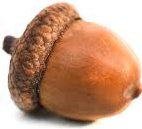 I grew up in a Britain recovering from World War II. My family had been missing the luxury of real coffee and had learnt to make do with acorns, roasted in the oven, ground in a hand grinder and subsequently brewed in a “percolator”. The percolator was a demonic device that repeatedly recycled boiling hot water over the grounds to extract every last drop of what my grandmother insisted on calling “the goodness”.
I grew up in a Britain recovering from World War II. My family had been missing the luxury of real coffee and had learnt to make do with acorns, roasted in the oven, ground in a hand grinder and subsequently brewed in a “percolator”. The percolator was a demonic device that repeatedly recycled boiling hot water over the grounds to extract every last drop of what my grandmother insisted on calling “the goodness”.
When post-war conditions improved it became possible to buy jars of cheap ground coffee mixed with roasted chicory. The percolator thrived on this stuff. I’ve seen it argued that chicory, because it contributes a bitter, coffee-like flavour without adding any caffeine, is a healthy supplement to regular coffee. I won’t argue. But you won’t get me to drink it.
This was Britain through the ’40s and the first half of the ’50s. Which explains the enthusiasm that greeted the arrival of Gaggia coffee bars. The price of one shilling and three pence per cappuccino was exorbitant* but you could nurse a single cup all evening.
And the product of the home percolator, which had never been inviting, became thereafter entirely unacceptable.
In those days transistorised computers had just arrived but cost millions of pounds. I dreamed of owning one and somehow actually knew I would some day. But having one of those glamorous espresso machines to call my own—unthinkable.
You can see how this colours my sentiments about the Fracino Piccino. The current price of the Piccino version 2, updated since I bought ours*, is around £900, or a little less if you explore the market.
(Many thanks, Huw.)
It would be an insult to the machine to do the exercise of dividing the capital cost (plus occasional 3-5 year servicing from Fracino) by the number of cups it’s delivered costed at high street prices. But I think we can guess who wins that one hands down.
And in any case, perhaps especially in the very interesting times we find ourselves in now, the sheer pleasure of being able to make a very decent cup of espresso, cappuccino, macchiato, latte or whatever for whoever fancies it or whenever the whim takes me, trumps everything.
Chris Bidmead

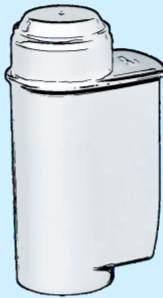

Hands down the best espresso lesson that I’ve ever had the pleasure to read and absorb. Apparently, I will be purchasing a Francino to keep my Olympia Cremina 67 company.
Thanks, Jerry. This one was particularly fun to write.
–
Chris
I bought my Piccino about 6 months ago and make about 3-4 cups per day with it. I am now unable to drink instant, filter, capsule or any other type of coffee. Nuff said.
The Piccino’s not the bee’s knees of espresso machines by any means. But, by golly, it’s a solid device at a decent price.
Ours has been back to Fracino for servicing about three times (they do a fine job) during our very nearly decade-long ownership and is as fit for duty as ever. Modern electronics has got us used to the idea that you chuck stuff away every three years or so. But that simply doesn’t apply to the Piccino.
Be good friends with yours, Richard. It promises to be a long relationship.
—
Chris
Thank you; great review and insight into coffee and coffee machines. Presently I am searching for a new espresso machine (my Gaggia Classic, purchased in 2008 is being retired) and being an ex engineer want a solid machine that I could keep in tip top condition; would you say the Fracino brand (I do like the Classico) falls into that category; plus it would be nice to buy a uk machine.
That Gaggia Classic was a great choice, Terry. User-maintainable and modifiable. Fracino would be a good step up — an excellent UK company with a very responsive service team. I had a problem at the beginning of this year with the steam boiler failing (the machine is very nearly ten years old now). The feed into the boiler had blown off. I sent Fracino photos and rather than ship the whole machine up to Birmingham they sent me the necessary spare part with instructions and I fixed it myself. Time saving, money saving — and very satisfying.
The Classico looks good. If I were in the market in that price range (I was lucky enough to buy the Piccino from a third-party on eBay as a demo unit at a knock-down price) I’d consider the PID version of the Piccino.
—
Chris
Thanks Chris for the feedback; I’ve been searching for a new machine now for a couple of weeks; it’s a minefield out there. I don’t think I’ll get one that will last like the Gaggia; it’s so simple with the single boiler; But you’re piccino may do; I just want something a little faster than the Gaggia for 2/3 milky coffee’s, that’s the Classics weak spot. I do like the aesthetics of the Classico; I’ll see if I can get a deal; up to now best I’ve seen it for £1150 and the Piccino for £850 (no PID) a lot of money; then again 2008 was the last time I purchased a coffee machine; I could have gone through 3 or 4 Sage units :)
Cheers
Terry
Hey Chris
I have one of these machines and love it. recently (and ONLY when I use the steam wand) it trips the electrics in my house. Any thoughts and tips appreciated. Also looking for folk in sheffield or close who might take a look and have a go at fixing it. really missing morning coffee!
You don’t say whether you hear the vibratory pump kick in when you use the steam wand. Either way, I suspect this pump is the culprit. Releasing steam will power up the pump, which may be shorting and causing your trip. These vibratory pumps are relatively short-lived but inexpensive components.
Why not drop an email to Fracino? I’ve found the company very responsive over the past ten years I’ve been running our Piccino. They can give you a price for shipping the machine to Birmingham for a full service and repair. Or (if you feel up to a bit of engineering) might be able to send you the replacement part. It’s possible that they may know of a competent repair shop in Sheffield that could do the job.
—
Chris
Well… what a wonderfully well written review! Very refreshing… some history, personal nostalgia, technical tips and that subtle underlying wry humour that is our own in this land. Lovely.
I’ve had my head in coffee machines online for a little while. My expected budget has nearly quadrupled to an outlay that I’ll have to keep secret from others who, not being coffee drinkers (or, worse, being instant drinkers!), would think me mad.
So I arrived at the Fracino Piccino via a learning curve of steel & double boilers, tamping and “dialling in”. Finally a horrifying video of “modding” the Gaggia Classic Evo to install a PID temperature control system has persuaded me that for the price of a reasonable self-build greenhouse I can stand at the kitchen window and contemplate the empty space in the back garden, sipping the first “pull” of that day’s rich and amazing speciality coffee, while from the corner of my eye the solidity of the Piccino on the kitchen counter will grant me some reassurance in our turbulent, hectic times.
That’s it, decision made. Grazie mille.
Many thanks for the appreciation, David. I’m happy to report that our Piccino is still going strong after more than 10 years serving the family. I believe Fracino’s newer versions have some improvements, but our old Piccino remains a solid workhorse.
—
Chris